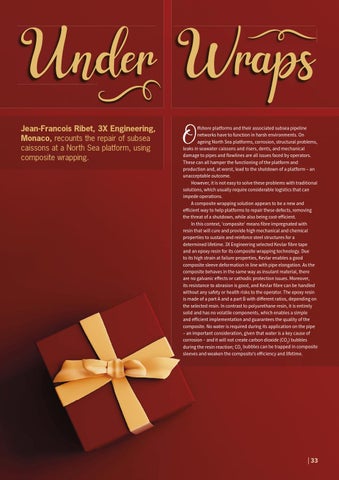Jean-Francois Ribet, 3X Engineering, Monaco, recounts the repair of subsea caissons at a North Sea platform, using composite wrapping.
ffshore platforms and their associated subsea pipeline networks have to function in harsh environments. On ageing North Sea platforms, corrosion, structural problems, leaks in seawater caissons and risers, dents, and mechanical damage to pipes and flowlines are all issues faced by operators. These can all hamper the functioning of the platform and production and, at worst, lead to the shutdown of a platform – an unacceptable outcome. However, it is not easy to solve these problems with traditional solutions, which usually require considerable logistics that can impede operations. A composite wrapping solution appears to be a new and efficient way to help platforms to repair these defects, removing the threat of a shutdown, while also being cost-efficient. In this context, ‘composite’ means fibre impregnated with resin that will cure and provide high mechanical and chemical properties to sustain and reinforce steel structures for a determined lifetime. 3X Engineering selected Kevlar fibre tape and an epoxy resin for its composite wrapping technology. Due to its high strain at failure properties, Kevlar enables a good composite sleeve deformation in line with pipe elongation. As the composite behaves in the same way as insulant material, there are no galvanic effects or cathodic protection issues. Moreover, its resistance to abrasion is good, and Kevlar fibre can be handled without any safety or health risks to the operator. The epoxy resin is made of a part A and a part B with different ratios, depending on the selected resin. In contrast to polyurethane resin, it is entirely solid and has no volatile components, which enables a simple and efficient implementation and guarantees the quality of the composite. No water is required during its application on the pipe – an important consideration, given that water is a key cause of corrosion – and it will not create carbon dioxide (CO2) bubbles during the resin reaction; CO2 bubbles can be trapped in composite sleeves and weaken the composite’s efficiency and lifetime.
| 33













